Day-Night Differences, Seasonal Variations and Source Apportionment of PM10-Bound PAHs over Xi’an, Northwest China
Abstract
:1. Introduction
2. Experimental
2.1. Sample Collections
2.2. PAHs Analysis
2.3. Positive Matrix Factorization (PMF) Analysis
3. Results and Discussion
3.1. Concentration Levels and Day–Night Differences
3.2. Seasonal Variations
3.3. PAH Partition Capacity in PM10
3.4. Source Apportionment by PMF
4. Conclusions
Supplementary Materials
Acknowledgments
Author Contributions
Conflicts of Interest
References
- Zhang, Y.; Tao, S.; Shen, H.; Ma, J. Inhalation exposure to ambient polycyclic aromatic hydrocarbons and lung cancer risk of Chinese population. Proc. Natl. Acad. Sci. USA 2009, 106, 21063–21067. [Google Scholar] [CrossRef] [PubMed]
- Shen, H.; Huang, Y.; Wang, R.; Zhu, D.; Li, W.; Shen, G.; Wang, B.; Zhang, Y.; Chen, Y.; Lu, Y. Global atmospheric emissions of polycyclic aromatic hydrocarbons from 1960 to 2008 and future predictions. Environ. Sci. Technol. 2013, 47, 6415–6424. [Google Scholar] [CrossRef] [PubMed]
- Kim, K.-H.; Jahan, S.A.; Kabir, E.; Brown, R.J. A review of airborne polycyclic aromatic hydrocarbons (PAHs) and their human health effects. Environ. Int. 2013, 60, 71–80. [Google Scholar] [CrossRef] [PubMed]
- Ravindra, K.; Sokhi, R.; Van Grieken, R. Atmospheric polycyclic aromatic hydrocarbons: Source attribution, emission factors and regulation. Atmos. Environ. 2008, 42, 2895–2921. [Google Scholar] [CrossRef] [Green Version]
- Keyte, I.J.; Harrison, R.M.; Lammel, G. Chemical reactivity and long-range transport potential of polycyclic aromatic hydrocarbons—A review. Chem. Soc. Rev. 2013, 42, 9333–9391. [Google Scholar] [CrossRef] [PubMed]
- Li, X.; Yang, Y.; Xu, X.; Xu, C.; Hong, J. Air pollution from polycyclic aromatic hydrocarbons generated by human activities and their health effects in China. J. Clean. Prod. 2016, 112, 1360–1367. [Google Scholar] [CrossRef]
- Ravindra, K.; Bencs, L.; Wauters, E.; De Hoog, J.; Deutsch, F.; Roekens, E.; Bleux, N.; Berghmans, P.; Van Grieken, R. Seasonal and site-specific variation in vapour and aerosol phase PAHs over flanders (Belgium) and their relation with anthropogenic activities. Atmos. Environ. 2006, 40, 771–785. [Google Scholar] [CrossRef]
- Wei, C.; Han, Y.; Bandowe, B.A.M.; Cao, J.; Huang, R.-J.; Ni, H.; Tian, J.; Wilcke, W. Occurrence, gas/particle partitioning and carcinogenic risk of polycyclic aromatic hydrocarbons and their oxygen and nitrogen containing derivatives in Xi’an, central China. Sci. Total Environ. 2015, 505, 814–822. [Google Scholar] [CrossRef] [PubMed]
- Liu, J.; Li, J.; Lin, T.; Liu, D.; Xu, Y.; Chaemfa, C.; Qi, S.; Liu, F.; Zhang, G. Diurnal and nocturnal variations of PAHs in the Lhasa atmosphere, Tibetan Plateau: Implication for local sources and the impact of atmospheric degradation processing. Atmos. Res. 2013, 124, 34–43. [Google Scholar] [CrossRef]
- Duan, J.; Tan, J.; Wang, S.; Chai, F.; He, K.; Hao, J. Roadside, urban, and rural comparison of size distribution characteristics of PAHs and carbonaceous components of Beijing, China. J. Atmos. Chem. 2012, 69, 337–349. [Google Scholar] [CrossRef]
- He, J.; Fan, S.; Meng, Q.; Sun, Y.; Zhang, J.; Zu, F. Polycyclic aromatic hydrocarbons (PAHs) associated with fine particulate matters in Nanjing, China: Distributions, sources and meteorological influences. Atmos. Environ. 2014, 89, 207–215. [Google Scholar] [CrossRef]
- Boström, C.-E.; Gerde, P.; Hanberg, A.; Jernström, B.; Johansson, C.; Kyrklund, T.; Rannug, A.; Törnqvist, M.; Victorin, K.; Westerholm, R. Cancer risk assessment, indicators, and guidelines for polycyclic aromatic hydrocarbons in the ambient air. Environ. Health Perspect. 2002, 110, 451–488. [Google Scholar] [CrossRef] [PubMed]
- Bi, X.; Sheng, G.; Peng, P.A.; Chen, Y.; Zhang, Z.; Fu, J. Distribution of particulate-and vapor-phase n-alkanes and polycyclic aromatic hydrocarbons in urban atmosphere of Guangzhou, China. Atmos. Environ. 2003, 37, 289–298. [Google Scholar] [CrossRef]
- Huang, R.-J.; Zhang, Y.; Bozzetti, C.; Ho, K.-F.; Cao, J.-J.; Han, Y.; Daellenbach, K.R.; Slowik, J.G.; Platt, S.M.; Canonaco, F. High secondary aerosol contribution to particulate pollution during haze events in China. Nature 2014, 514, 218–222. [Google Scholar] [CrossRef] [PubMed] [Green Version]
- Cao, J.; Wu, F.; Chow, J.; Lee, S.; Li, Y.; Chen, S.; An, Z.; Fung, K.; Watson, J.; Zhu, C. Characterization and source apportionment of atmospheric organic and elemental carbon during fall and winter of 2003 in Xi’an, China. Atmos. Chem. Phys. 2005, 5, 3127–3137. [Google Scholar] [CrossRef]
- Han, Z.; Zhang, R.; Wang, Q.G.; Wang, W.; Cao, J.; Xu, J. Regional modeling of organic aerosols over China in summertime. J. Geophys. Res. Atmos. 2008, 113. [Google Scholar] [CrossRef]
- Shen, Z.; Arimoto, R.; Cao, J.; Zhang, R.; Li, X.; Du, N.; Okuda, T.; Nakao, S.; Tanaka, S. Seasonal variations and evidence for the effectiveness of pollution controls on water-soluble inorganic species in total suspended particulates and fine particulate matter from Xi’an, China. J. Air Waste Manag. Assoc. 2008, 58, 1560–1570. [Google Scholar] [PubMed]
- Cao, J.-J.; Zhang, T.; Chow, J.C.; Watson, J.G.; Wu, F.; Li, H. Characterization of atmospheric ammonia over Xi’an, China. Aerosol Air Qual. Res. 2009, 9, 277–289. [Google Scholar] [CrossRef]
- Shen, Z.; Cao, J.; Arimoto, R.; Han, Z.; Zhang, R.; Han, Y.; Liu, S.; Okuda, T.; Nakao, S.; Tanaka, S. Ionic composition of TSP and PM2.5 during dust storms and air pollution episodes at Xi’an, China. Atmos. Environ. 2009, 43, 2911–2918. [Google Scholar] [CrossRef]
- Bandowe, B.A.M.; Meusel, H.; Huang, R.-J.; Ho, K.; Cao, J.; Hoffmann, T.; Wilcke, W. PM2.5-bound oxygenated PAHs, nitro-PAHs and parent-PAHs from the atmosphere of a Chinese megacity: Seasonal variation, sources and cancer risk assessment. Sci. Total Environ. 2014, 473, 77–87. [Google Scholar] [CrossRef] [PubMed]
- Xu, H.; Ho, S.S.H.; Gao, M.; Cao, J.; Guinot, B.; Ho, K.F.; Long, X.; Wang, J.; Shen, Z.; Liu, S. Microscale spatial distribution and health assessment of PM2.5-bound polycyclic aromatic hydrocarbons (PAHs) at nine communities in Xi’an, China. Environ. Pollut. 2016, 218, 1065–1073. [Google Scholar] [CrossRef] [PubMed]
- Wang, J.; Cao, J.; Dong, Z.; Guinot, B.; Gao, M.; Huang, R.; Han, Y.; Huang, Y.; Ho, S.S.H.; Shen, Z. Seasonal variation, spatial distribution and source apportionment for polycyclic aromatic hydrocarbons (PAHs) at nineteen communities in Xi’an, China: The effects of suburban scattered emissions in winter. Environ. Pollut. 2017, 231, 1330–1343. [Google Scholar] [CrossRef] [PubMed]
- Shen, Z.; Han, Y.; Cao, J.; Tian, J.; Zhu, C.; Liu, S.; Liu, P.; Wang, Y. Characteristics of traffic-related emissions: A case study in roadside ambient air over Xi’an, China. Aerosol Air Qual. Res. 2010, 10, 292–300. [Google Scholar] [CrossRef]
- Shen, Z.; Cao, J.; Zhang, L.; Liu, L.; Zhang, Q.; Li, J.; Han, Y.; Zhu, C.; Zhao, Z.; Liu, S. Day–night differences and seasonal variations of chemical species in PM10 over Xi’an, northwest China. Environ. Sci. Pollut. Res. 2014, 21, 3697–3705. [Google Scholar] [CrossRef] [PubMed]
- USEPA. Positive Matrix Factorization 5.0 Fundamentals and User Guide. Available online: https://www.epa.gov/air-research/epa-positive-matrix-factorization-50-fundamentals-and-user-guide (accessed on 4 February 2018).
- Cheng, J.; Yuan, T.; Wu, Q.; Zhao, W.; Xie, H.; Ma, Y.; Ma, J.; Wang, W. PM10-bound polycyclic aromatic hydrocarbons (PAHs) and cancer risk estimation in the atmosphere surrounding an industrial area of Shanghai, China. Water Air Soil Pollut. 2007, 183, 437–446. [Google Scholar] [CrossRef]
- Tan, J.-H.; Bi, X.-H.; Duan, J.-C.; Rahn, K.A.; Sheng, G.-Y.; Fu, J.-M. Seasonal variation of particulate polycyclic aromatic hydrocarbons associated with PM10 in Guangzhou, China. Atmos. Res. 2006, 80, 250–262. [Google Scholar] [CrossRef]
- Liu, G.; Tong, Y.; Luong, J.H.; Zhang, H.; Sun, H. A source study of atmospheric polycyclic aromatic hydrocarbons in Shenzhen, south China. Environ. Monit. Assess. 2010, 163, 599–606. [Google Scholar] [CrossRef] [PubMed]
- Li, X.; Wang, Y.; Guo, X.; Wang, Y. Seasonal variation and source apportionment of organic and inorganic compounds in PM2.5 and PM10 particulates in Beijing, China. Environ. Sci. 2013, 25, 741–750. [Google Scholar] [CrossRef]
- Harrison, R.M.; Smith, D.; Luhana, L. Source apportionment of atmospheric polycyclic aromatic hydrocarbons collected from an urban location in Birmingham, UK. Environ. Sci. Technol. 1996, 30, 825–832. [Google Scholar] [CrossRef]
- Clark, P.J. An extension of the coefficient of divergence for use with multiple characters. Copeia 1952, 2, 61–64. [Google Scholar] [CrossRef]
- Wongphatarakul, V.; Friedlander, S.; Pinto, J. A comparative study of PM2.5 ambient aerosol chemical databases. Environ. Sci. Technol. 1998, 32, 3926–3934. [Google Scholar] [CrossRef]
- Yang, F.; Ye, B.; He, K.; Ma, Y.; Cadle, S.H.; Chan, T.; Mulawa, P.A. Characterization of atmospheric mineral components of PM2.5 in Beijing and Shanghai, China. Sci. Total Environ. 2005, 343, 221–230. [Google Scholar] [CrossRef] [PubMed]
- Shen, Z.; Cao, J.; Liu, S.; Zhu, C.; Wang, X.; Zhang, T.; Xu, H.; Hu, T. Chemical composition of PM10 and PM2.5 collected at ground level and 100 meters during a strong winter-time pollution episode in Xi’an, China. J. Air Waste Manag. Assoc. 2011, 61, 1150–1159. [Google Scholar] [CrossRef] [PubMed]
- Shen, Z.; Wang, X.; Zhang, R.; Ho, K.; Cao, J.; Zhang, M. Chemical composition of water-soluble ions and carbonate estimation in spring aerosol at a semi-arid site of Tongyu, China. Aerosol Air Qual. Res. 2011, 11, 360–368. [Google Scholar] [CrossRef]
- Wang, X.; Shen, Z.; Cao, J.; Zhang, L.; Liu, L.; Li, J.; Liu, S.; Sun, Y. Characteristics of surface ozone at an urban site of Xi’an in northwest China. J. Environ. Monit. 2012, 14, 116–126. [Google Scholar] [CrossRef] [PubMed]
- Zhang, Q.; Shen, Z.; Cao, J.; Zhang, R.; Zhang, L.; Huang, R.-J.; Zheng, C.; Wang, L.; Liu, S.; Xu, H. Variations in PM2.5, TSP, BC and trace gases (NO2, SO2, and O3) between haze and non-haze episodes in winter over Xi’an, China. Atmos. Environ. 2015, 112, 64–71. [Google Scholar] [CrossRef]
- Sousa, G.; Kiselev, D.; Kasparian, J.; George, C.; Ferreira, J.; Favreau, P.; Lazzarotto, B.; Wolf, J.-P. Time-resolved monitoring of polycyclic aromatic hydrocarbons adsorbed on atmospheric particles. Environ. Sci. Pollut. Res. 2017, 24, 19517–19523. [Google Scholar] [CrossRef] [PubMed]
- Fang, G.-C.; Wu, Y.-S.; Chen, J.-C.; Fu, P.P.-C.; Chang, C.-N.; Ho, T.-T.; Chen, M.-H. Characteristic study of polycyclic aromatic hydrocarbons for fine and coarse particulates at pastureland near industrial park sampling site of central Taiwan. Chemosphere 2005, 60, 427–433. [Google Scholar] [CrossRef] [PubMed]
- Tsapakis, M.; Stephanou, E.G. Occurrence of gaseous and particulate polycyclic aromatic hydrocarbons in the urban atmosphere: Study of sources and ambient temperature effect on the gas/particle concentration and distribution. Environ. Pollut. 2005, 133, 147–156. [Google Scholar] [CrossRef] [PubMed]
- Shen, Z.; Zhang, L.; Cao, J.; Tian, J.; Liu, L.; Wang, G.; Zhao, Z.; Wang, X.; Zhang, R.; Liu, S. Chemical composition, sources, and deposition fluxes of water-soluble inorganic ions obtained from precipitation chemistry measurements collected at an urban site in northwest China. J. Environ. Monit. 2012, 14, 3000–3008. [Google Scholar] [CrossRef] [PubMed]
- Ho, K.; Ho, S.S.H.; Lee, S.; Cheng, Y.; Chow, J.C.; Watson, J.G.; Louie, P.K.K.; Tian, L. Emissions of gas-and particle-phase polycyclic aromatic hydrocarbons (PAHs) in the Shing Mun Tunnel, Hong Kong. Atmos. Environ. 2009, 43, 6343–6351. [Google Scholar] [CrossRef]
- Tan, J.; Guo, S.; Ma, Y.; Duan, J.; Cheng, Y.; He, K.; Yang, F. Characteristics of particulate PAHs during a typical haze episode in Guangzhou, China. Atmos. Res. 2011, 102, 91–98. [Google Scholar] [CrossRef]
- Dachs, J.; Eisenreich, S.J. Adsorption onto aerosol soot carbon dominates gas-particle partitioning of polycyclic aromatic hydrocarbons. Environ. Sci. Technol. 2000, 34, 3690–3697. [Google Scholar] [CrossRef]
- Odabasi, M.; Cetin, E.; Sofuoglu, A. Determination of octanol–air partition coefficients and supercooled liquid vapor pressures of PAHs as a function of temperature: Application to gas–particle partitioning in an urban atmosphere. Atmos. Environ. 2006, 40, 6615–6625. [Google Scholar] [CrossRef]
- Miguel, A.H.; Kirchstetter, T.W.; Harley, R.A.; Hering, S.V. On-road emissions of particulate polycyclic aromatic hydrocarbons and black carbon from gasoline and diesel vehicles. Environ. Sci. Technol. 1998, 32, 450–455. [Google Scholar] [CrossRef]
- Ma, Y.; Cheng, Y.; Qiu, X.; Lin, Y.; Cao, J.; Hu, D. A quantitative assessment of source contributions to fine particulate matter (PM2.5)-bound polycyclic aromatic hydrocarbons (PAHs) and their nitrated and hydroxylated derivatives in Hong Kong. Environ. Pollut. 2016, 219, 742–749. [Google Scholar] [CrossRef] [PubMed]
- Gupta, S.; Kumar, K.; Srivastava, A.; Srivastava, A.; Jain, V. Size distribution and source apportionment of polycyclic aromatic hydrocarbons (PAHs) in aerosol particle samples from the atmospheric environment of Delhi, India. Sci. Total Environ. 2011, 409, 4674–4680. [Google Scholar] [CrossRef] [PubMed]
- Wang, J.; Ho, S.S.H.; Huang, R.; Gao, M.; Liu, S.; Zhao, S.; Cao, J.; Wang, G.; Shen, Z.; Han, Y. Characterization of parent and oxygenated-polycyclic aromatic hydrocarbons (PAHs) in Xi’an, China during heating period: An investigation of spatial distribution and transformation. Chemosphere 2016, 159, 367–377. [Google Scholar] [CrossRef] [PubMed]
- Liu, D.; Lin, T.; Syed, J.H.; Cheng, Z.; Xu, Y.; Li, K.; Zhang, G.; Li, J. Concentration, source identification, and exposure risk assessment of PM2.5-bound parent PAHs and nitro-PAHs in atmosphere from typical Chinese cities. Sci. Rep. 2017, 7, 10398. [Google Scholar] [CrossRef] [PubMed]
- Callén, M.S.; Iturmendi, A.; López, J.M. Source apportionment of atmospheric PM2.5-bound polycyclic aromatic hydrocarbons by a PMF receptor model. Assessment of potential risk for human health. Environ. Pollut. 2014, 195, 167–177. [Google Scholar] [CrossRef] [PubMed]
- Okuda, T.; Okamoto, K.; Tanaka, S.; Shen, Z.; Han, Y.; Huo, Z. Measurement and source identification of polycyclic aromatic hydrocarbons (PAHs) in the aerosol in Xi’an, China, by using automated column chromatography and applying positive matrix factorization (PMF). Sci. Total Environ. 2010, 408, 1909–1914. [Google Scholar] [CrossRef] [PubMed]
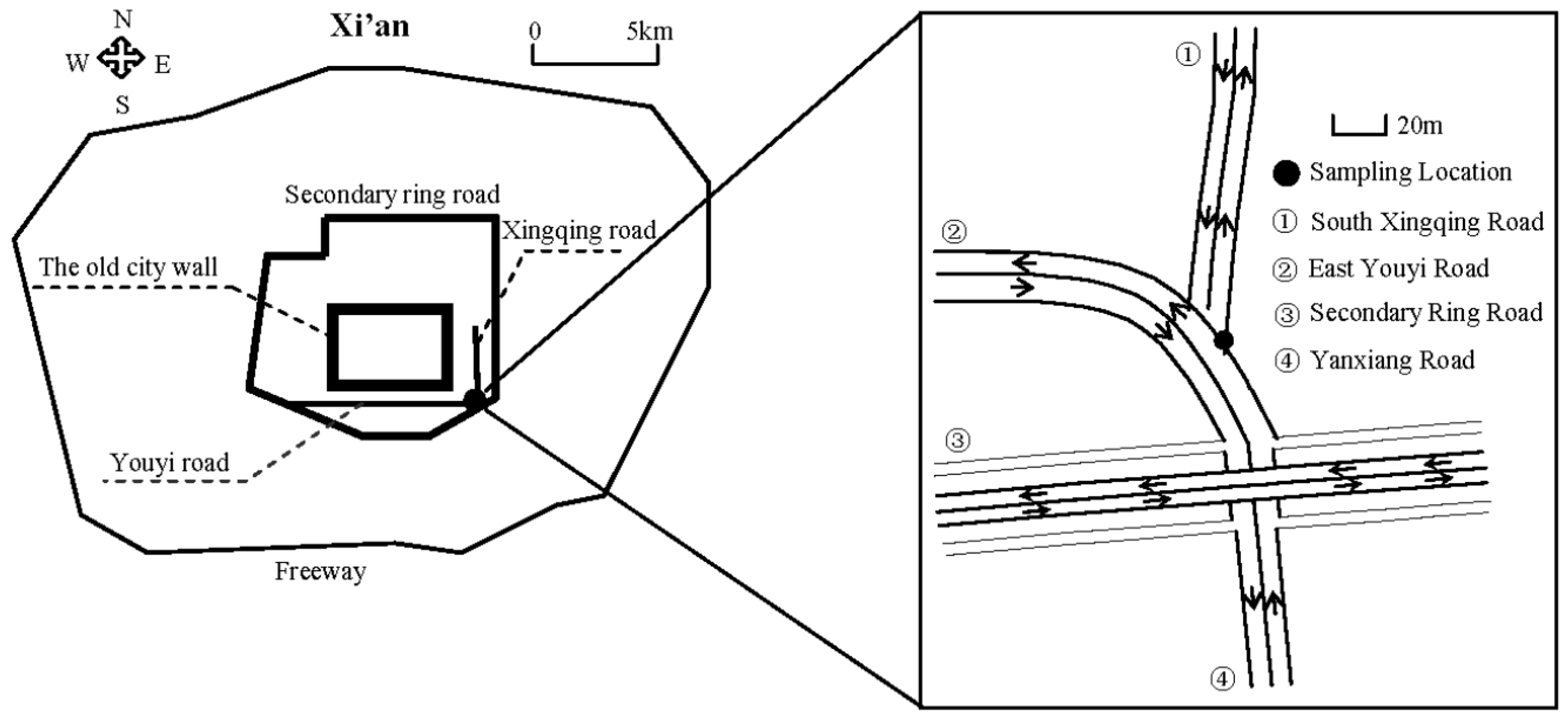
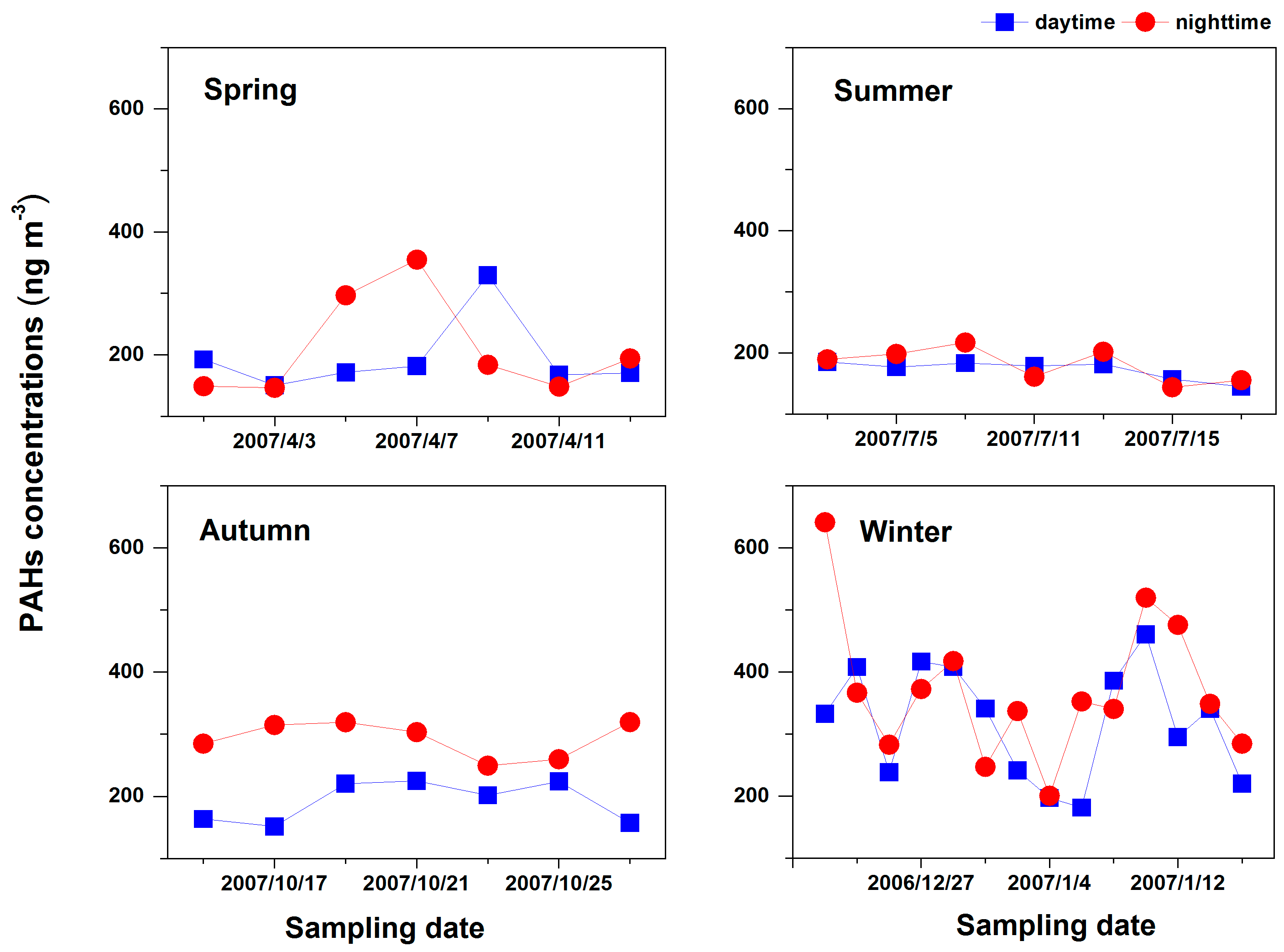
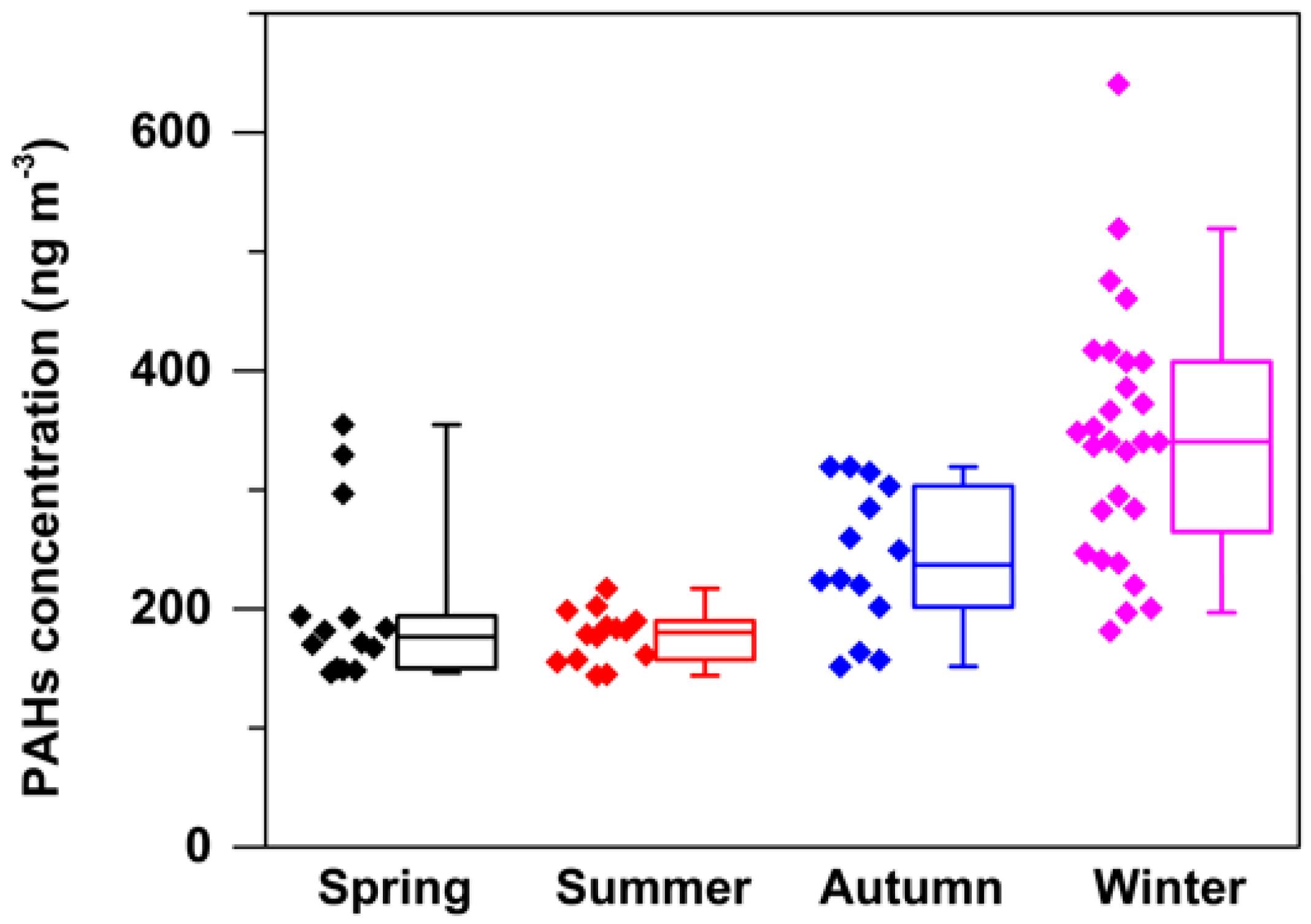

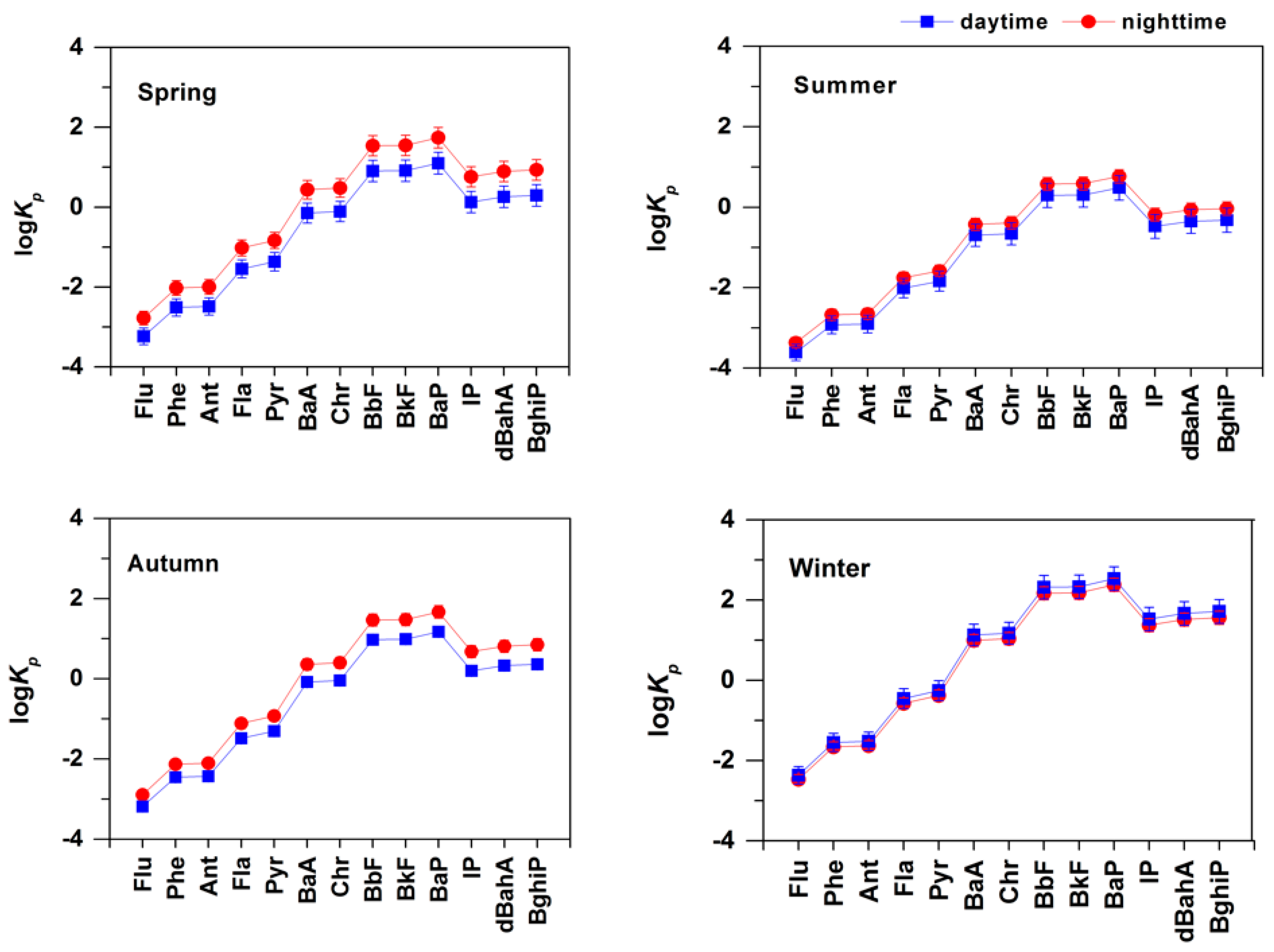

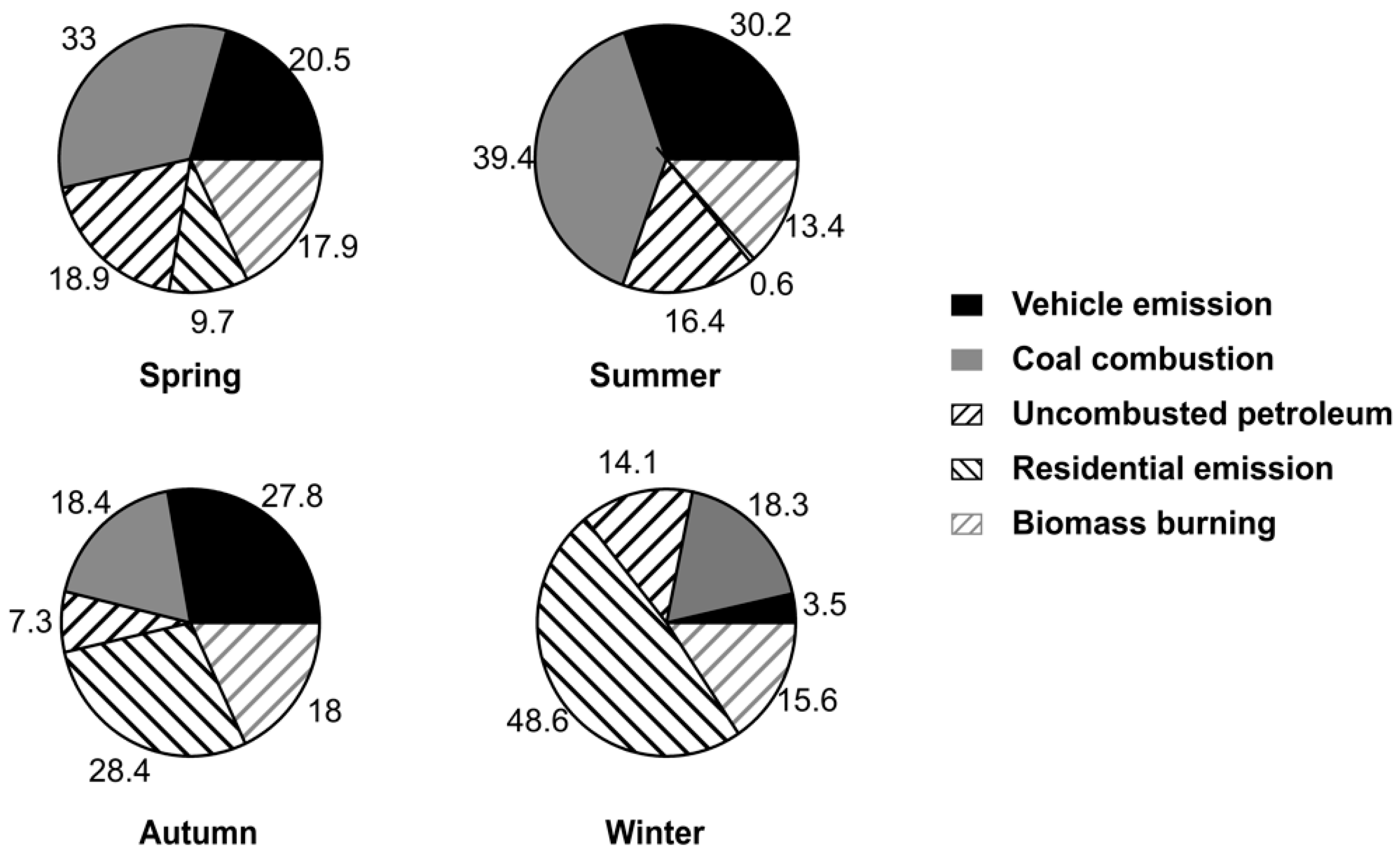
| PAHs Concentrations (ng m−3) | ∑PAHs (ng m−3) | |||||||||||||
|---|---|---|---|---|---|---|---|---|---|---|---|---|---|---|
| Season | Flu | Phe | Ant | FLA | Pyr | BaA | Chr | BbF | BkF | BaP | IP | dBahA | BghiP | |
| Spring | 6.5 | 9.8 | 4.9 | 15.0 | 10.2 | 8.9 | 18.8 | 27.8 | 18.8 | 14.2 | 13.7 | 13.7 | 40.4 | 202.6 |
| Summer | 5.2 | 6.7 | 3.3 | 10.0 | 5.3 | 6.7 | 15.7 | 24.4 | 19.3 | 12.2 | 11.8 | 15.3 | 41.3 | 177.0 |
| Autumn | 5.3 | 7.5 | 7.2 | 23.5 | 18.9 | 11.9 | 20.2 | 31.5 | 20.8 | 20.8 | 22.0 | 13.4 | 39.5 | 242.4 |
| Winter | 6.9 | 9.4 | 28.6 | 35.6 | 31.1 | 20.7 | 37.1 | 39.3 | 27.1 | 32.4 | 23.4 | 13.3 | 39.6 | 344.6 |
| Annual | 6.2 | 8.5 | 14.5 | 23.9 | 19.3 | 13.8 | 25.8 | 32.5 | 22.6 | 22.4 | 18.8 | 13.8 | 40.1 | 262.2 |
© 2018 by the authors. Licensee MDPI, Basel, Switzerland. This article is an open access article distributed under the terms and conditions of the Creative Commons Attribution (CC BY) license (http://creativecommons.org/licenses/by/4.0/).
Share and Cite
Wang, X.; Shen, Z.; Zeng, Y.; Liu, F.; Zhang, Q.; Lei, Y.; Xu, H.; Cao, J.; Yang, L. Day-Night Differences, Seasonal Variations and Source Apportionment of PM10-Bound PAHs over Xi’an, Northwest China. Atmosphere 2018, 9, 62. https://doi.org/10.3390/atmos9020062
Wang X, Shen Z, Zeng Y, Liu F, Zhang Q, Lei Y, Xu H, Cao J, Yang L. Day-Night Differences, Seasonal Variations and Source Apportionment of PM10-Bound PAHs over Xi’an, Northwest China. Atmosphere. 2018; 9(2):62. https://doi.org/10.3390/atmos9020062
Chicago/Turabian StyleWang, Xin, Zhenxing Shen, Yaling Zeng, Fobang Liu, Qian Zhang, Yali Lei, Hongmei Xu, Junji Cao, and Liu Yang. 2018. "Day-Night Differences, Seasonal Variations and Source Apportionment of PM10-Bound PAHs over Xi’an, Northwest China" Atmosphere 9, no. 2: 62. https://doi.org/10.3390/atmos9020062





